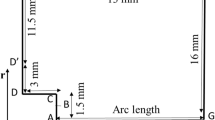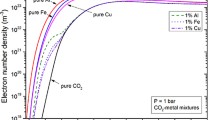Abstract
C4F7N is one of the most promising candidate to replace SF6 as arc quenching medium. Some buffer gases (N2 and CO2) are usually mixed with C4F7N to reduce the operating temperature. In order to provide priori knowledge of the arc quenching performance for C4F7N mixtures, the plasma properties including equilibrium compositions, thermodynamic properties, transport coefficients, and net emission coefficients of C4F7N–N2 and C4F7N–CO2 arc plasmas are calculated and the effects of buffer gases are discussed. Taking these properties as input, a 1D arc decaying model is constructed to describe arc decaying characteristics. According to the evolution of axial temperature and arc conductance over time, the arc decaying process is divided into three stages, i.e. the thermal recovery stage, the pre-dielectric recovery stage, and the post-dielectric recovery stage. We focus on the first two stages and describe them by the thermal recovery time (or rate) and the pre-dielectric recovery time (or rate) respectively. According to the results of 1D arc decaying modelling, the descending order of the thermal recovery ability for the gases studied in this work is: SF6 > C4F7N > 75%C4F7N–25%N2 > 75%C4F7N–25%CO2 > 50%C4F7N–50%N2 > 25%C4F7N–75%N2 > 50%C4F7N–50%CO2 > CO2 > 25%C4F7N–75%CO2 > N2; and the pre-dielectric recovery ability is: N2 > SF6 > CO2 > 25%C4F7N–75%CO2 > 25%C4F7N–75%N2 > 50%C4F7N–50%CO2 > 75%C4F7N–25%CO2 > 50%C4F7N–50%N2 > 75%C4F7N–25%N2 > C4F7N.














Similar content being viewed by others
References
Zhong L, Cressault Y, Teulet P (2018) Thermophysical and radiation properties of high-temperature C4F8–CO2 mixtures to replace SF6 in high-voltage circuit breakers. Phys Plasmas 25(3):033502. https://doi.org/10.1063/1.5012850
Zhong L, Wang J, Wang X, Rong M (2018) Comparison of dielectric breakdown properties for different carbon-fluoride insulating gases as SF6 alternatives. AIP Adv 8(8):085122
Taki M, Maekawa D, Odaka H, Mizoguchi H, Yanabu S (2007) Interruption capability of CF3I gas as a substitution candidate for SF6 gas. IEEE Trans Dielectr Electr Insul 14(2):341–346
Wang X, Zhong L, Yan J, Yang A, Han G, Han G, Wu Y, Rong M (2015) Investigation of dielectric properties of cold C3F8 mixtures and hot C3F8 gas as substitutes for SF6. Eur Phys J D 69(10):240. https://doi.org/10.1140/epjd/e2015-60327-9
Kieffel Y (2016) Characteristics of g3—an alternative to SF6. In: 2016 IEEE international conference on dielectrics (ICD). IEEE, pp 880–884
Kieffel Y, Irwin T, Ponchon P, Owens J (2016) Green gas to replace SF6 in electrical grids. IEEE Power Energy Mag 14(2):32–39
Wu Y, Wang C, Sun H, Murphy AB, Rong M, Yang F, Chen Z, Niu C, Wang X (2018) Properties of C4F7N–CO2 thermal plasmas: thermodynamic properties, transport coefficients and emission coefficients. J Phys D Appl Phys 51(15):155206
Zhong L, Rong M, Wang X, Wu J, Han G, Han G, Lu Y, Yang A, Wu Y (2017) Compositions, thermodynamic properties, and transport coefficients of high-temperature C5F10O mixed with CO2 and O2 as substitutes for SF6 to reduce global warming potential. AIP Adv 7(7):075003
Zhang X, Li Y, Tian S, Xiao S, Chen D, Tang J, Zhuo R (2018) Decomposition mechanism of the C5-PFK/CO2 gas mixture as an alternative gas for SF6. Chem Eng J 336:38–46
Zhang X, Li Y, Xiao S, Tang J, Tian S, Deng Z (2017) Decomposition mechanism of C5F10O: an environmentally friendly insulation medium. Environ Sci Technol 51(17):10127–10136
Li Y, Zhang X, Tian S, Xiao S, Li Y, Chen D (2019) Insight into the decomposition mechanism of C6F12O–CO2 gas mixture. Chem Eng J 360:929–940. https://doi.org/10.1016/j.cej.2018.10.167
Seeger M, Smeets R, Yan J, Ito H, Claessens M, Dullni E, Falkingham L, Franck C, Gentil F, Hartmann W (2017) Recent trends in development of high voltage circuit breakers with SF6 alternative gases. In: XXII symposium on physics of switching arc (FSO), 2017. Czech Technical University in Prague, Department of Physics, FEE
Radisavljevic B, Stoller PC, Doiron CB, Over D (2017) Switching performance of alternative gaseous mixtures in high-voltage circuit breakers. Paper presented at the the 20th international symposium on high voltage engineering, Buenos Aires
Kieffel Y, Biquez F (2015) SF6 alternative development for high voltage switchgears. Paper presented at the 2015 IEEE electrical insulation conference (EIC), Seattle, Washington
Li X, Guo X, Murphy AB, Zhao H, Wu J, Guo Z (2017) Calculation of thermodynamic properties and transport coefficients of C5F10O–CO2 thermal plasmas. J Appl Phys 122(14):143302
Rong M, Zhong L, Cressault Y, Gleizes A, Wang X, Chen F, Zheng H (2014) Thermophysical properties of SF6–Cu mixtures at temperatures of 300–30,000 K and pressures of 0.01–1.0 MPa: part 1. Equilibrium compositions and thermodynamic properties considering condensed phases. J Phys D Appl Phys 47(49):495202. https://doi.org/10.1088/0022-3727/47/49/495202
Malcolm W, Chase J (1998) NIST-JANAF thermochemical tables (fourth edition). American Chemical Society and American Institute of Physics
Burcat A, Ruscic B (2005) Third millenium ideal gas and condensed phase thermochemical database for combustion with updates from active thermochemical tables. Argonne National Laboratory, Argonne
Frisch MJ, Trucks GW, Schlegel HB, Scuseria GE, Robb MA, Cheeseman JR, Scalmani G, Barone V, Petersson GA, Nakatsuji H, Li X, Caricato M, Marenich AV, Bloino J, Janesko BG, Gomperts R, Mennucci B, Hratchian HP, Ortiz JV, Izmaylov AF, Sonnenberg JL, Williams DF, Lipparini F, Egidi F, Goings J, Peng B, Petrone A, Henderson T, Ranasinghe D, Zakrzewski VG, Gao J, Rega N, Zheng G, Liang W, Hada M, Ehara M, Toyota K, Fukuda R, Hasegawa J, Ishida M, Nakajima T, Honda Y, Kitao O, Nakai H, Vreven T, Throssell K, Montgomery Jr JA, Peralta JE, Ogliaro F, Bearpark MJ, Heyd JJ, Brothers EN, Kudin KN, Staroverov VN, Keith TA, Kobayashi R, Normand J, Raghavachari K, Rendell AP, Burant JC, Iyengar SS, Tomasi J, Cossi M, Millam JM, Klene M, Adamo C, Cammi R, Ochterski JW, Martin RL, Morokuma K, Farkas O, Foresman JB, Fox DJ (2016) Gaussian 16 Rev. B.01, Wallingford, CT
Coufal O, Živný O (2011) Composition and thermodynamic properties of thermal plasma with condensed phases. Eur Phys J D 61(1):131–151. https://doi.org/10.1140/epjd/e2010-10211-3
Liu J, Zhang Q, Yan J, Zhong J, Fang M (2016) Analysis of the characteristics of DC nozzle arcs in air and guidance for the search of SF6 replacement gas. J Phys D Appl Phys 49(43):435201
Cressault Y, Connord V, Hingana H, Teulet P, Gleizes A (2011) Transport properties of CF3I thermal plasmas mixed with CO2, air or N2 as an alternative to SF6 plasmas in high-voltage circuit breakers. J Phys D Appl Phys 44(49):495202. https://doi.org/10.1088/0022-3727/44/49/495202
Murphy AB (2012) Transport coefficients of plasmas in mixtures of nitrogen and hydrogen. Chem Phys 398:64–72. https://doi.org/10.1016/j.chemphys.2011.06.017
Wang X, Zhong L, Cressault Y, Gleizes A, Rong M (2014) Thermophysical properties of SF6–Cu mixtures at temperatures of 300–30,000 K and pressures of 0.01–1.0 MPa: part 2. Collision integrals and transport coefficients. J Phys D Appl Phys 47(49):495201. https://doi.org/10.1088/0022-3727/47/49/495201
Yang A, Liu Y, Zhong L, Wang X, Niu C, Rong M, Han G, Zhang Y, Lu Y, Wu Y (2016) Thermodynamic properties and transport coefficients of CO2–Cu thermal plasmas. Plasma Chem Plasma Process 36(4):1141–1160. https://doi.org/10.1007/s11090-016-9709-2
Zhong L, Wang X, Cressault Y, Teulet P, Rong M (2016) Influence of metallic vapours on thermodynamic and transport properties of two-temperature air plasma. Phys Plasmas 23(9):093514. https://doi.org/10.1063/1.4963245
Zhong L, Wang X, Rong M, Cressault Y (2016) Effects of copper vapour on thermophysical properties of CO2–N2 plasma. Eur Phys J D 70(11):233
Cressault Y, Hannachi R, Teulet P, Gleizes A, Gonnet JP, Battandier JY (2008) Influence of metallic vapours on the properties of air thermal plasmas. Plasma Sources Sci Technol 17(3):035016. https://doi.org/10.1088/0963-0252/17/3/035016
Teulet P, Gonzalez JJ, Mercado-Cabrera A, Cressault Y, Gleizes A (2009) One-dimensional hydro-kinetic modelling of the decaying arc in air–PA66–copper mixtures: II. Study of the interruption ability. J Phys D Appl Phys 42(18):185207. https://doi.org/10.1088/0022-3727/42/18/185207
NIST Computational Chemistry Comparison and Benchmark Database (2013) NIST standard reference database number 101 release 16a. http://cccbdb.nist.gov/. Accessed 2 Jan 2019
Murphy AB (2010) The effects of metal vapour in arc welding. J Phys D Appl Phys 43(43):434001. https://doi.org/10.1088/0022-3727/43/43/434001
Gleizes A (2014) Perspectives on thermal plasma modelling. Plasma Chem Plasma Process 35(3):455–469. https://doi.org/10.1007/s11090-014-9589-2
Liebermann R, Lowke J (1976) Radiation emission coefficients for sulfur hexafluoride arc plasmas. J Quant Spectrosc Radiat Transfer 16(3):253–264
Zhong L (2017) Influence of copper contamination on thermophysical, radiation, and dielectric breakdown properties of CO2–N2 mixtures as replacement of SF6 in circuit breakers. Université Toulouse III - Paul Sabatier, Toulouse
NIST Atomic Spectra Database (version 5.3) (2015) National Institute of Standards and Technology. http://physics.nist.gov/asd. Accessed 12 May 2016
Kurucz RL, Peytremann E (1975) A table of semiempirical gf values. Part 1: wavelengths: 5.2682 nm to 272.3380 nm. SAO special report, vol 362
Kurucz RL, Peytremann E (1975) A table of semiempirical gf values. Part 2: wavelengths: 272.3395 nm to 599.3892 nm. SAO special report, vol 362
Kurucz RL, Peytremann E (1975) A table of semiempirical gf values. Part 3: wavelengths: 599.4004 nm to 9997.2746 nm. SAO special report, vol 362
Rothman LS, Gordon IE, Babikov Y, Barbe A, Benner DC, Bernath PF, Birk M, Bizzocchi L, Boudon V, Brown LR (2013) The HITRAN2012 molecular spectroscopic database. J Quant Spectrosc Radiat Transf 130:4–50
Zhong L, Cressault Y, Teulet P (2019) Evaluation of arc quenching ability for a gas by combining 1-D hydrokinetic modeling and boltzmann equation analysis. IEEE Trans Plasma Sci 47(4):1835–1840
Chervy B, Gonzalez J-J, Gleizes A (1996) Calculation of the interruption capability of SF6–CF4 and SF6–C2F6 mixtures. II. Arc decay modeling. IEEE Trans Plasma Sci 24(1):210–217
Yokomizu Y, Ochiai R, Matsumura T (2009) Electrical and thermal conductivities of high-temperature CO2–CF3I mixture and transient conductance of residual arc during its extinction process. J Phys D Appl Phys 42(21):215204. https://doi.org/10.1088/0022-3727/42/21/215204
Acknowledgements
This work was supported in part by the Natural Science Foundation of Jiangsu Province (BK20180387) and the State Key Laboratory of Electrical Insulation and Power Equipment (EIPE18207).
Author information
Authors and Affiliations
Corresponding author
Additional information
Publisher's Note
Springer Nature remains neutral with regard to jurisdictional claims in published maps and institutional affiliations.
Rights and permissions
About this article
Cite this article
Zhong, L., Wang, J., Xu, J. et al. Effects of Buffer Gases on Plasma Properties and Arc Decaying Characteristics of C4F7N–N2 and C4F7N–CO2 Arc Plasmas. Plasma Chem Plasma Process 39, 1379–1396 (2019). https://doi.org/10.1007/s11090-019-10015-8
Received:
Accepted:
Published:
Issue Date:
DOI: https://doi.org/10.1007/s11090-019-10015-8




